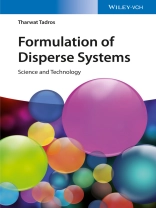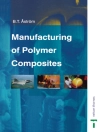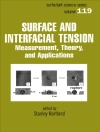This book presents comprehensively the science and technology behind the formulation of disperse systems like emulsions, suspensions, foams and others. Starting with a general introduction, the book covers a broad range of topics like the role of different classes of surfactants, stability of disperse systems, formulation of different dispersions, evaluation of formulations and many more. Many examples are included, too. Written by the experienced author and editor Tharwart Tadros, this book is indispensable for every scientist working in the field.
สารบัญ
Preface
GENERAL INTRODUCTION
Suspensions
Latexes
Emulsions
Suspoemulsions
Multiple Emulsions
Nanosuspensions
Nanoemulsions
Microemulsions
Pigment and Ink Dispersions
Foams
SURFACTANTS USED IN FORMULATION OF DISPERSIONS
General Classification of Surface-Active Agents
PHYSICAL CHEMISTRY OF SURFACTANT SOLUTIONS AND THE PROCESS OF MICELLISATION
Thermodynamics of Micellisation
Enthalpy and Entropy of Micellisation
DISPERSANTS AND POLYMERIC SURFACTANTS
Solution Properties of Polymeric Surfactants
General Classification of Polymeric Surfactants
Polyelectrolytes
ADSORPTION OF SURFACTANTS AT THE AIR/LIQUID, LIQUID/LIQUID, AND SOLID/LIQUID INTERFACES
Introduction
Adsorption of Surfactants at the Air/Liquid (A/L) and Liquid/Liquid (L/L) Interfaces
The Gibbs Adsorption Isotherm
Equation of State Approach
The Langmuir, Szyszkowski, and Frumkin Equations
Interfacial Tension Measurements
Adsorption of Surfactants at the Solid/Liquid (S/L) Interface
ADSORPTION OF POLYMERIC SURFACTANTS AT THE SOLID/LIQUID INTERFACE
Theories of Polymer Adsorption
Experimental Techniques for Studying Polymeric Surfactant Adsorption
Determination of Segment Density Distribution p(z) and Adsorbed Layer Thickness
Examples of the Adsorption Isotherms of Nonionic Polymeric Surfactants
COLLOID STABILITY OF DISPERSE SYSTEMS CONTAINING ELECTRICAL DOUBLE LAYERS
Origin of Charge on Surfaces
Structure of the Electrical Double Layer
Stern-Grahame Model of the Double Layer
Distinction between Specific and Nonspecific Adsorbed Ions
Electrical Double Layer Repulsion
van der Waals Attraction
Total Energy of Interaction
Flocculation of Suspensions
Criteria for Stabilisation of Dispersions with Double Layer Interaction
STABILITY OF DISPERSE SYSTEMS CONTAINING ADSORBED NONIONIC SURFACTANTS OR POLYMERS: STERIC STABILISATION
Introduction
Interaction between Particles Containing Adsorbed Nonionic and Polymeric Surfactant Layers (Steric Stabilisation)
Mixing Interaction Gmix
Elastic Interaction Gel
Total Energy of Interaction
Criteria for Effective Steric Stabilisation
Flocculation of Sterically Stabilised Dispersions
FORMULATION OF SOLID/LIQUID DISPERSIONS (SUSPENSIONS)
Introduction
Preparation of Suspensions
Condensation Methods: Nucleation and Growth
Dispersion Methods
Bulk Properties of Suspensions
FORMULATION OF LIQUID/LIQUID DISPERSIONS (EMULSIONS)
Introduction
Industrial Applications of Emulsions
Physical Chemistry of Emulsion Systems
Adsorption of Surfactants at the Liquid/Liquid Interface
Selection of Emulsifiers
Creaming or Sedimentation of Emulsions
Flocculation of Emulsions
General Rules for Reducing (Eliminating) Flocculation
Ostwald Ripening
Emulsion Coalescence
Phase Inversion
FORMULATION OF SUSPOEMULSIONS (MIXTURES OF SUSPENSIONS AND EMULSIONS)
Introduction
Suspoemulsions in Paints
Suspoemulsions in Agrochemicals
FORMULATION OF MULTIPLE EMULSIONS
Introduction
Preparation of Multiple Emulsions
Types of Multiple Emulsions
Breakdown Processes of Multiple Emulsions
Factors Affecting Stability of Multiple Emulsions, and Criteria for Their Stabilisation
General Description of Polymeric Surfactants
Interaction between Oil or Water Droplets Containing an Adsorbed Polymeric Surfactant: Steric Stabilisation
Examples of Multiple Emulsions Using Polymeric Surfactants
Characterisation of Multiple Emulsions
Rheological Measurements
PREPARATION OF NANOSUSPENSIONS
Introduction
Nucleation and Growth, and Control of Particle Size Distribution
Preparation of Nanosuspensions by Bottom-Up Processes
Preparation of Nanosuspensions Using the Bottom-Down Process
FORMULATION OF NANOEMULSIONS
Introduction
Mechanism of Emulsification
Methods of Emulsification and the Role of Surfactants
Preparation of Nanoemulsions
Steric Stabilisation and the Role of the Adsorbed Layer Thickness
FORMULATION OF MICROEMULSIONS
Introduction
Thermodynamic Definition of Microemulsions
Mixed-Film and Solubilisation Theories of Microemulsions
Thermodynamic Theory of Microemulsion Formation
Characterisation of Microemulsions Using Scattering Techniques
Characterisation of Microemulsions Using Conductivity
NMR Measurements
Formulation of Microemulsions
FORMULATION OF FOAMS
Introduction
Foam Preparation
Foam Structure
Classification of Foam Stability
Drainage and Thinning of Foam Films
Theories of Foam Stability
Foam Inhibitors
Physical Properties of Foams
Experimental Techniques for Studying Foams
FORMULATION OF LATEXES
Introduction
Emulsion Polymerisation
Polymeric Surfactants for Stabilisatoin of Preformed Latex Dispersions
Dispersion Polymerisation
FORMULATION OF PIGMENT AND INK DISPERSIONS
Introduction
Powder Wetting
Breaking of Aggregates and Agglomerates (Deagglomeration)
Classification of Dispersants
METHODS OF EVALUATING FORMULATIONS AFTER DILUTION
Introduction
Assessment of the Structure of the Solid/Liquid Interface
Assessment of Sedimentation of Suspensions
Assessment of Flocculation and Ostwald Ripening (Crystal Growth)
Scattering Techniques
Measurement of Rate of Flocculation
Measurement of Incipient Flocculation
Measurement of Crystal Growth (Ostwald Ripening)
Bulk Properties of Suspensions: Equilibrium Sediment Volume (or Height) and Redispersion
EVALUATING FORMULATIONS WITHOUT DILUTION: RHEOLOGICAL TECHNIQUES
Introduction
Steady-State Measurements
Constant Stress (Creep) Measurements
Dynamic (Oscillatory) Measurements
ASSESSMENT AND PREDICTION OF CREAMING, SEDIMENTATION, FLOCCULATIO, AND COALESCENCE OF FORMULATIONS
Assessment and Prediction of Creaming and Sedimentation
Assessment and Prediction of Flocculation Using Rheological Techniques
Assessment and Prediction of Emulsion Coalescence Using Rheological Techniques
Index
เกี่ยวกับผู้แต่ง
Tharwat F. Tadros is a consultant for various chemical industries. After finishing his Ph D at Alexandria University, he was appointed lecturer in Physical Chemistry (1962-1966) at the same university. Between 1966 and 1969, he spent a sabbatical at the Agricultural University of Wageningen and T.N.O in Delft, the Netherlands. Thereafter he worked at I.C.I. and ZENECA until 1994, where he researched various fields of surfactants, emulsions, suspensions, microemulsions, wetting spreading and adhesion, and rheology. During that period he was also appointed visiting professor at Imperial College London, Bristol University and Reading University. In 1992, he was elected President of the International Association of Colloid and Interface Science. Since leaving ZENECA, Dr. Tadros has worked as a consultant and also given several courses in his specialized field. He is the recipient of two medals from the Royal Society of Chemistry in the UK, and has more than 250 scientific papers to his name.












